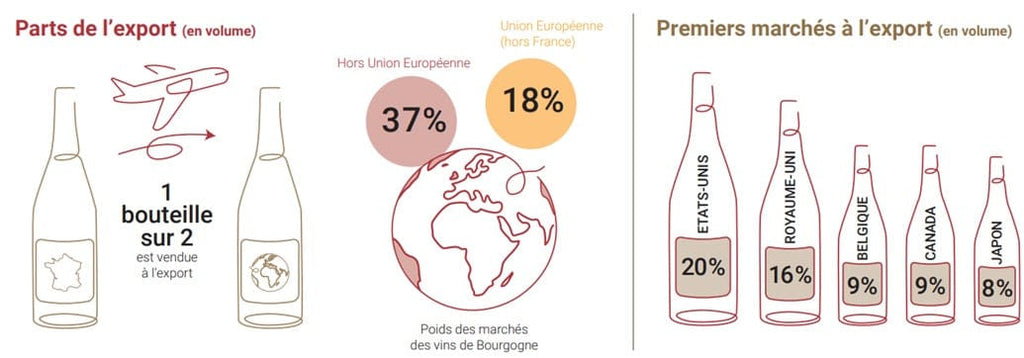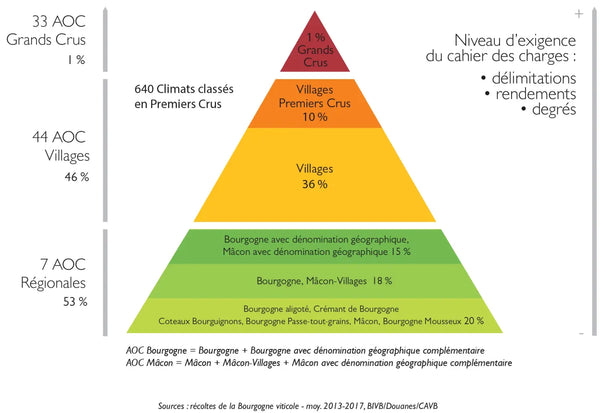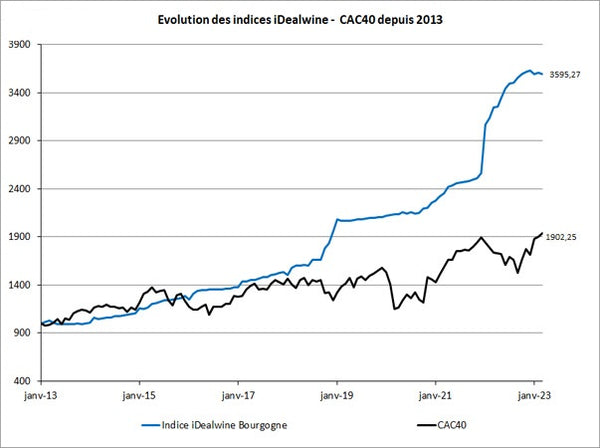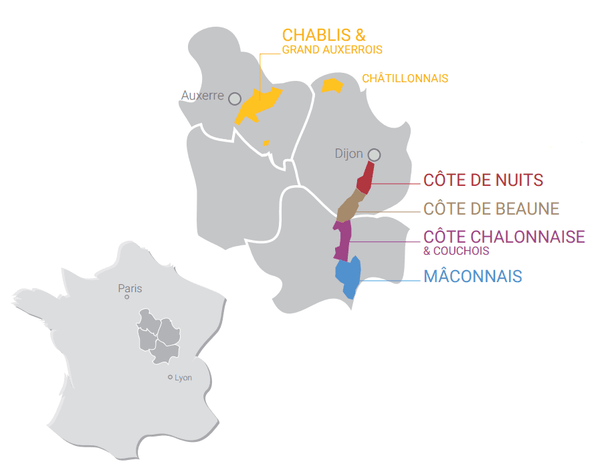A region adored by wine enthusiasts, Burgundy undoubtedly produces some of the finest Pinot Noir and Chardonnay wines in the world. Nevertheless, vintage after vintage, the prices of the region's wines continue to rise, making their acquisition increasingly difficult for the non-wealthy enthusiast.
But then, why are Burgundy wines on average more expensive compared to those from other regions of France? Why is this trend accelerating?
Many factors come into play here.
Summary
Supply and demand
Located in the northeast of France, the Burgundy region is made up of 30,000 hectares, representing only 4% of the French vineyard. In comparison, the Bordeaux region covers 120,000 hectares (16% of the vineyard) while the vineyards of the Rhône Valley stretch over 79,000 hectares (10.5% of the vineyard).
This size difference has a significant impact on the quantities produced. Thus, for 200 million bottles produced each year in Burgundy, 650 million are put on the market for Bordeaux and 465 million for the Rhône Valley.
As you will have understood, and although these figures are very general, the supply is much more limited in Burgundy...and this inevitably has an impact on the final price of your bottle!
The average size of an estate is also a decisive factor that partly explains certain price differences. Indeed, while the average size of a wine estate in Burgundy is 8.2 hectares, it is 12 hectares in France ! As a result, economies of scale are inevitably lower for a Burgundy winemaker, thus requiring them to better enhance the value of their production.
Moreover, this production scarcity faces an ever-increasing national and international demand.
Indeed, today, nearly one in two bottles of Burgundy is exported. While the traditional customers are the United States (21% of exported volumes), England (17%), Belgium (9%), Canada (9%), and Japan (8%), many other countries are now seeking a share of the market.
If this increase in demand allows Burgundy winemakers to better distribute their sales, it also makes the distribution of volumes more complex each year among all market players, once again driving up prices.

Key figures for Burgundy wine exports
Finally, climatic hazards, although not affecting only Burgundy, also have a clear impact on prices. Thus, the terrible 2021 vintage for example represented half of a normal production for the region. As a result, and in order to compensate for this significant quantitative shortfall, prices saw average increases ranging from 20 to 30%...and strangely, the excellent 2022 vintage will not, for its part, bring prices down.Go figure…
The classification of the vineyard
Another factor explaining the high price levels in Burgundy is the great reputation of the classification system used in the region.
This system actually ranks the plots throughout the region, starting at the level of regional appellations, moving through the Village AOCs, and finally ending with the very precise delimitation of plots (or climats) classified as Premier Cru (10% of the vineyard) and Grand Cru (1% of the vineyard).
Although this system of valuing the region’s finest terroirs offers many advantages, this hierarchy nevertheless directs consumers towards the most sought-after 11% of the vineyard and therefore puts additional pressure on the prices of the finest cuvées.
As an example, the recognition as Premier Cru in 2020 of 200 hectares in the Pouilly-Fuissé AOC resulted in the prices of wines originating from these vineyards increasing by a good ten euros from one year to the next simply due to the added value of this production.

The hierarchy pyramid of Burgundy wines
Land prices
While we have seen that the levels of supply and demand as well as the classification of the Burgundy vineyard are all factors that greatly influence prices, another important factor also explains the increase in rates year after year: land prices.
The purchase of land in Burgundy has indeed become a significant investment and the prices of the region's vineyards are the highest in the world.
For example, in 2019, the average price of a hectare of Burgundy Grand Cru was 6.5 million euros! Still in the same year, a hectare of Chardonnay Premier Cru cost nearly 1.65 million euros while a hectare of Pinot Noir of the same level was worth more than €700,000. Did you say outrageous?
It's simple, in ten years, the price of vineyards has at least doubled, even tripled, and for some plots, increased tenfold. A crazy situation that calls into question the traditional model of small-scale family production on which the region was built.
Successions are indeed becoming increasingly complex. Indeed, if an estate owns a few ouvrées of a Grand Cru as well as several hectares in a village appellation, the fees to be paid for the former will far exceed those for the rest of the property. There is often only one solution available to the young successors : to part with their most prestigious lands.
Beyond these inheritance matters, and unless one has a very significant starting capital, it has also become impossible for young winemakers to set up in the region.
While this surge in prices particularly affects the Côte-de-Nuits as well as the Côte-de-Beaune, the two most sought-after sub-regions of the vineyard, this situation is now also spreading to less valued lands, thus contributing to a generalized increase in prices.
To illustrate the extravagance of certain transactions here are two examples. In 2014, the Clos des Lambrays, a very famous Burgundy estate with 11 hectares, was bought by Bernard Arnault for the modest sum of 110 million euros... that is, 10 million euros per hectare. But that's not the worst! In 2017, its neighbor, the Clos de Tart, the sole owner of the eponymous Grand Cru of 7.5 hectares, was sold to François Pinault for a sum close to 250 million euros, or over 33 million per hectare!
Have we reached the limit? No one knows... but this calls into question the historical organization of the entire vineyard. Indeed, in recent decades, many financial institutions (banks, insurance companies) as well as several wealthy investors have taken control of the most beautiful properties in the region.
Speculation
In addition to land prices, speculation has also taken hold of Burgundy wines since the early 2000s. Nevertheless, it almost exclusively affects the most renowned estates.
Thus, the year 2023 once again broke all auction records in the wine world: 33,000 euros for a bottle of Musigny Grand Cru 2006 from domaine Leroy, 31,620€ for a bottle of Romanée-Conti 2015 from domaine de la Romanée-Conti, or even 26,164€ for a bottle of Criots-Bâtard-Montrachet Grand Cru 2005 from domaine d'Auvenay !
Unreasonable? It is clear that some ultra-wealthy individuals (notably in China) are willing to do anything to acquire these prestigious bottles.
While some Burgundy estate owners are not entirely blameless regarding the situation, others are fighting to ensure that their precious bottles are enjoyed by true enthusiasts.Despite this, and by temptation of profit, some holders of iconic estates decide to resell their bottles, fully aware that they can get 4 times, 10 times, 20 times more than their purchase price.
This same speculation also has the consequence of encouraging counterfeiting. Indeed, without such large sums of money at stake, there would be no fake bottles on the market. A vicious circle, therefore.

Winedex Burgundy Index: price evolution of the 40 most expensive wines of the region, taking into account the last 10 vintages for each cuvée: +359% between 2013 and 2023
Burgundy is not the only one
Finally, it is clear that in recent years, prices have increased in all regions of France, and not only in Burgundy.
Indeed, although the latter has experienced greater increases than average, all winemakers in France, whether from Bordeaux, Loire, Alsace or even Languedoc-Roussillon have faced the same issues.
Thus, due to COVID, the war in Ukraine, or even various international conflicts, multiple raw materials have surged in price and many factories have operated at a slower pace, leading to shortages. This is particularly true for transportation (oil) and dry materials (glass, cardboard, labels, etc.) whose prices have soared.
Conclusion
As you will have understood, the concepts of supply and demand, the land classification system, land prices, as well as speculation are the most important parameters for understanding the sometimes completely crazy prices in the Burgundy region.
Nevertheless, rest assured, there are still many cuvées available in the region for those who know where to look, especially in the southern part of Burgundy (Mercurey, Mâcon, Saint-Véran, etc.) or in appellations in the less renowned northern part, which nevertheless produce delicious wines, such as Fixin, Marsannay or even the Hautes-Côtes de Beaune and the Hautes-Côtes de Nuits.
In any case, whether you are looking for a prestigious bottle or an excellent value for money, do not hesitate to contact La Cave Éclairée and ask for advice!

General map of the Burgundy vineyard















































